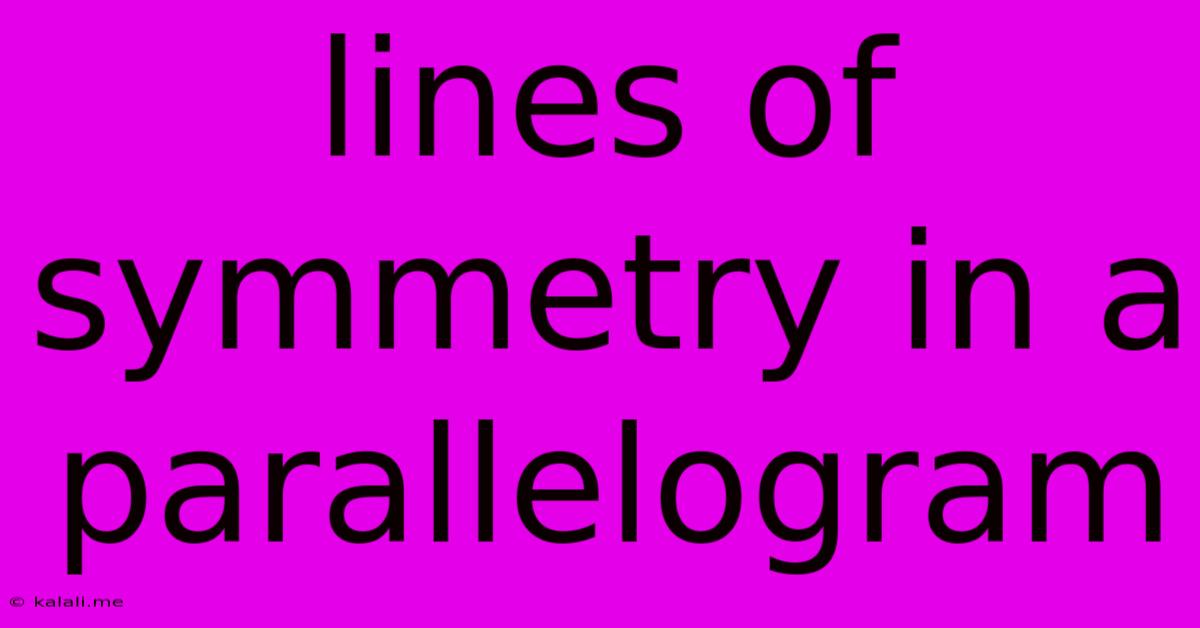Lines Of Symmetry In A Parallelogram
Kalali
Jun 15, 2025 · 3 min read

Table of Contents
Lines of Symmetry in a Parallelogram: A Comprehensive Guide
Meta Description: Discover the fascinating world of symmetry in parallelograms! This comprehensive guide explores the lines of symmetry in parallelograms, differentiating between various types and explaining why certain parallelograms possess them while others don't. Learn to identify symmetry and understand its geometric implications.
A parallelogram, a quadrilateral with opposite sides parallel, presents an interesting case study in geometric symmetry. While some shapes boast multiple lines of symmetry, understanding the symmetry (or lack thereof) in a parallelogram requires a closer look at its properties. This article will delve into the lines of symmetry in parallelograms, clarifying misconceptions and offering a clear understanding of this geometric concept.
What is a Line of Symmetry?
Before exploring the lines of symmetry in parallelograms, let's define the term. A line of symmetry, also known as a line of reflection, is a line that divides a shape into two identical halves that are mirror images of each other. If you were to fold the shape along the line of symmetry, the two halves would perfectly overlap.
Types of Parallelograms
To understand symmetry in parallelograms, we need to consider the different types:
- Rectangle: A parallelogram with four right angles.
- Square: A parallelogram with four right angles and four equal sides.
- Rhombus: A parallelogram with four equal sides.
- General Parallelogram: A parallelogram with opposite sides equal and parallel, but no right angles or equal adjacent sides.
Lines of Symmetry in Different Parallelograms
The number of lines of symmetry varies significantly depending on the type of parallelogram:
-
Rectangle: A rectangle has two lines of symmetry. These lines run through the midpoints of opposite sides.
-
Square: A square, being a special case of a rectangle and rhombus, possesses four lines of symmetry. Two lines connect opposite corners (diagonals) and two lines bisect opposite sides.
-
Rhombus: A rhombus has two lines of symmetry. These lines are its diagonals.
-
General Parallelogram: A general parallelogram, lacking right angles and equal adjacent sides, has no lines of symmetry.
Why the Differences?
The presence or absence of lines of symmetry directly relates to the properties of each parallelogram. The symmetry arises from the specific relationships between angles and side lengths. A rectangle's right angles create mirror symmetry across its horizontal and vertical axes. Similarly, a square's equal sides and right angles lead to additional diagonal lines of symmetry. The rhombus, with its equal sides, exhibits symmetry along its diagonals. The general parallelogram, however, lacks the necessary conditions for any lines of symmetry to exist.
Identifying Lines of Symmetry
When identifying lines of symmetry, consider the following:
- Visual Inspection: Examine the shape carefully and look for lines that would divide it into two identical halves.
- Folding Test (Conceptual): Imagine folding the shape along a potential line of symmetry. Do the two halves overlap perfectly?
- Coordinate Geometry: For more complex shapes, coordinate geometry can be employed to mathematically verify the existence of lines of symmetry.
Conclusion
The presence or absence of lines of symmetry in parallelograms is directly linked to its specific geometric properties. Understanding the differences between rectangles, squares, rhombuses, and general parallelograms is crucial in determining the number of lines of symmetry. By using visual inspection and applying the concept of reflection, you can accurately identify and understand the symmetry in these important geometric shapes.
Latest Posts
Latest Posts
-
How Many Triangles Are There In This Figure
Jun 15, 2025
-
Aptitude Tests Are Used To Indicate
Jun 15, 2025
-
What Layer Do Meteors Burn Up In
Jun 15, 2025
-
Difference Between An Article And A Journal
Jun 15, 2025
-
Which Of The Following Has The Highest Frequency
Jun 15, 2025
Related Post
Thank you for visiting our website which covers about Lines Of Symmetry In A Parallelogram . We hope the information provided has been useful to you. Feel free to contact us if you have any questions or need further assistance. See you next time and don't miss to bookmark.